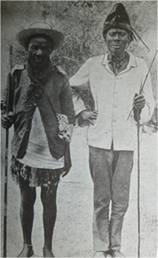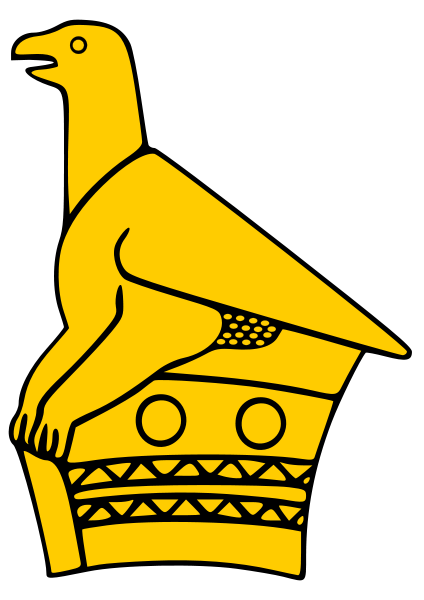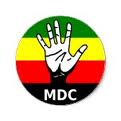Pioneer Days
And for the Matabele?
Records on these men (and two women) are less complete than we would like due to the vagaries of history. Much of what we know comes from contemporary accounts recorded by the whites (which are often uncomplimentary) or recollections published many years later and thus subject to the expected distortions.

Babyaan and Mtshede, 1897
- Mkwati and Tenkela
- As one of Lobengula’s “Black ants” Mkwati rose to importance through his marriage to Tenkela, the all important iwosana, messenger of Mwali, in the Mambo Hills who acted as the local voice and transmitting of information for the Mlimo Cult based in the Matobo Hills (Clarke 2008). Contrastingly, in Ranger’s (1967) Revolt, Mkwati is presented as only a regional instigator of the insurrections of 1896 in Matabeleland, Chigwedere (1991) sees him as only a messenger, preferring to incorrectly expand the role of “Shonas” in leading the uprising in Matabeleland. Relatively few details are however given and he is depicted as much the same as the more northern spirit mediums of the Shona heartland. Mkwati is further short-changed in later nationalist publications where he becomes a mere adjutant to events in Mashonaland. The importance of Mkwati was therefore not as a Shona medium, in the sense of Nehanda, but it was it association with Tenkela and her family. Mkwati spoke out and encouraged the local events of 1896 but he was not part of a massive nation-wide conspiracy against the colonial regime.
- Babyaan
- Well-known to the whites before the uprising, Babyaan had been one of the indunas (the other was Mtshede) to visit Queen Victoria in 1889 as part of Lobengula's attempt to contain the machinations of the BSACo. During the war he fought with Umlugulu.
- Queen Lozikeyi
- Lobengula's foremost wife, she has been presented as the brains behind the conception and planning of the War of the Red Axe (Clarke 2010). As the argument goes, “as bearer of the king's tradition and Queen Regent, she held the status of a man and was acting head of state” (Clarke 2010: 123). There are a few problems with this convincing thesis, not least the secrecy of her participation and the lack of specific documentary evidence. Lozikeyi ended her life in 1919 still fighting to preserve the autonomy of the Matabele and staving off attempts to alienate more of their land.
- Nyamanda
- See previous briefing.
- Umlugulu
- Selous regarded him as a relation of Lobengula's which accounted for his influence and power at the king's court. Umlugulu was one of the leaders during the annual inxwala festival. Selous (1896: 12) in the strong language of the times, said of him: "He was a very gentle-mannered savage, and always most courteous and polite in his bearing… this man was one of the chef instigators of the rebellion". Umlugulu led one of the main factions in the Matobo Hills and by the time of the first Indaba was acknowledged co-leader of the entire Matabele force along with Umfesela. Ranger (1967: 139) claims Umlugulu was “certainly at the centre of the planning which preceded the rising and after its outbreak he was a focus of loyalty for one of the two broad factions into which the rebels were divided”.
Sourced from the Zanj Financial Network 'Zfn', Harare, Zimbabwe, email briefing dated 28 March 2011


 South Devon Sound Radio
South Devon Sound Radio Museum of hp Calculators
Museum of hp Calculators Apollo Flight Journal
Apollo Flight Journal Apollo Lunar Surface Journal
Apollo Lunar Surface Journal Cloudy Nights Classic Telescopes
Cloudy Nights Classic Telescopes The Savanna - Saffer Shops in London
The Savanna - Saffer Shops in London Linux Mint
Linux Mint Movement for Democratic Change
Movement for Democratic Change